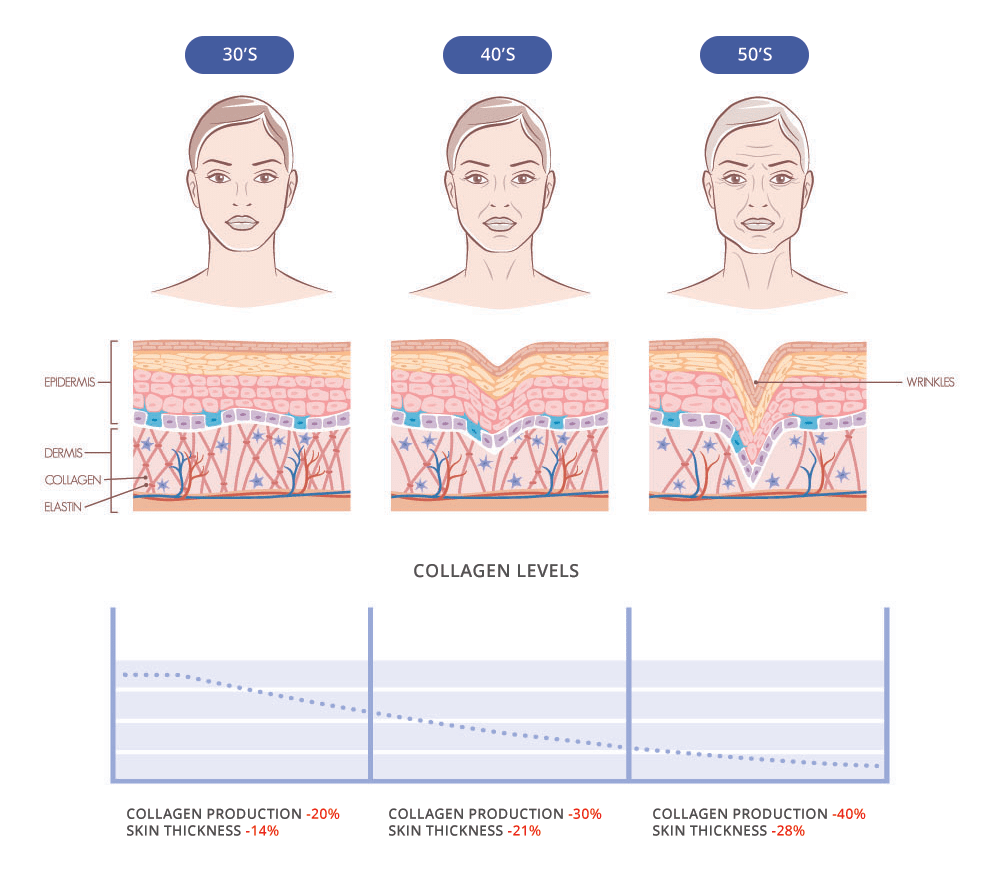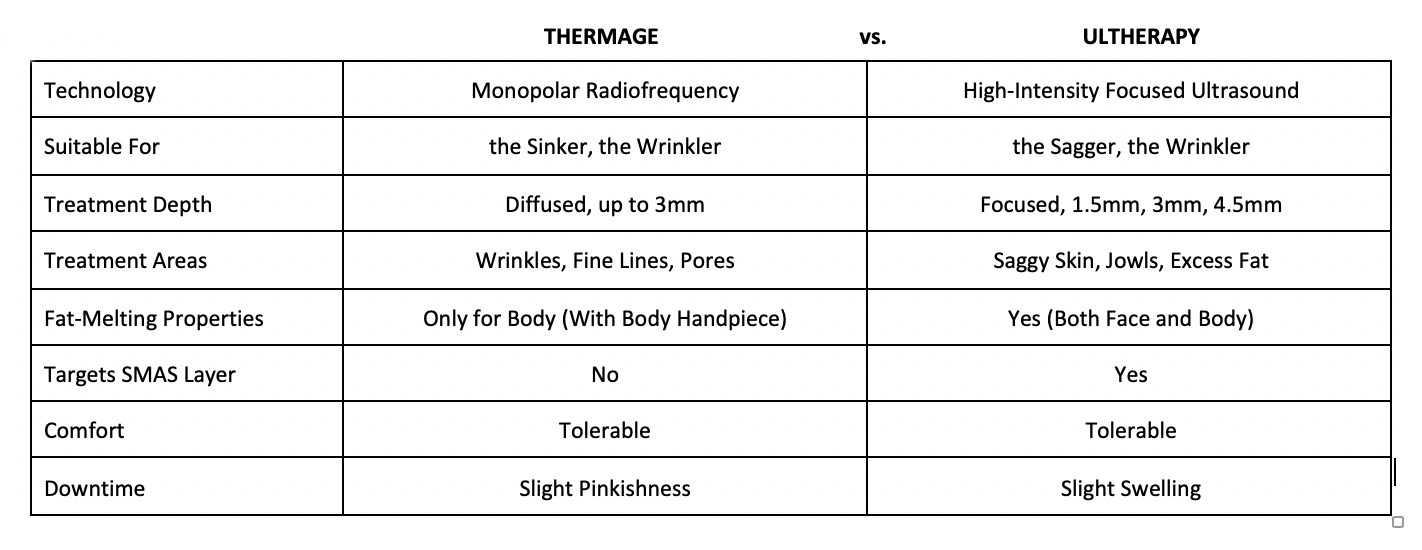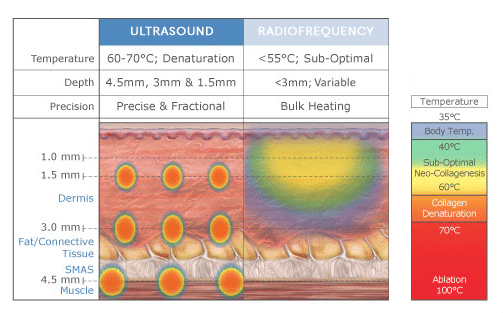Why do I need a non-surgical face lift?
We age everyday.
Wrinkles, fine lines, loose skin and saggy areas appear on our faces as we age. Much of this is due to the loss of collagen from our skin.

The dermis layer in our skin is approximately 80% Type I collagen (the most abundant type of collagen in our body), and another 15% consists of Type III collagen, fibroblasts, elastin and hyaluronic acid. Together, they are key components of our skin’s extracellular matrix and provide it with structure, elasticity and firmness.
From our mid to late 20s, our body’s own regenerating capability and production of collagen decreases. Despite our best efforts, we lose 1-2% of our collagen levels in the skin every year.
While surgery such as a “surgical face-lift” used to be the only option for treatment of wrinkles and skin laxity, a variety of non-surgical, non-invasive options are available today. Thermage and Ultherapy systems are two excellent examples of such, and we will be discussing them in more detail here.
Thermage vs Ultherapy – Which one am I more suitable for?
As we age, there are generally 3 categories of ageing styles we fall into, with each ageing style exhibiting distinct ageing traits. While we will almost certainly have a mix of features, this is a useful guide to explain how different treatments may be more suitable for different individuals.
The 3 aging styles are: “The Sinker”, “The Sagger” and “The Wrinkler“.

“Sinkers” are characterized by volume loss around key areas of the face such as the temples, mid-face and cheeks. This can cause a sunken, “hollowed-out” or gaunt appearance. Between Thermage and Ultherapy, Thermage is probably more suitable for sinkers as it does not melt fats and accelerate the gaunt appearance. Sinkers may also see more benefit with a combination of treatments including dermal fillers to combat the volume loss.

“Saggers” commonly complain of loose skin and tissue. This is due to the loss of elasticity in addition to collagen. Ultherapy is useful to stimulate tightening of the SMAS layer to achieve a deeper lifting effect; while melting some excess fat and tissue in the lower face helps to turn back the clock too.

“Wrinklers” have predominantly wrinkly skin, often located around the eyes, brows and lips. Botox would be able to achieve nice, immediately-visible results for these, but for a longer-lasting treatment, Thermage and/or Ultherapy can be used. A person with multiple wrinkles and fine lines on the brows, around the eyes and face may benefit more from Thermage, while one with wrinkles and also saggy skin may be more suitable for a Ultherapy.
How Thermage / Ultherapy works
Both Thermage and Ultherapy systems both use energy to invoke and restore collagen production in the dermal layer of the skin. However, the type of energy used is different: Thermage uses radio frequency (RF) energy while Ultherapy uses ultrasound (US) energy.
The heat energy generated from both Thermage and Ultherapy are able to penetrate the surface of the skin to the dermis layer to stimulate the production of collagen.

Thermage
The first tissue tighening device to debut in the USA and approved by FDA since 2002, Thermage uses monopolar radiofrequency technology to deliver heat to the deep dermis. It uses a technique known as bulk heating to tighten saggy skin, smooth wrinkles and stimulate new collagen production.
The primary response from the radiofrequency energy is immediate collagen contraction. This gives the tightening effect, followed by a secondary response of wound healing, which involves collagen remodelling and new collagen deposition. This causes the treatment effect to last for months after the initial treatment.
Bulk heating by radiofrequency is generally considered diffused under the skin. This enables Thermage to give an effective full-face rejuvenation and tightening effect.
Thermage heats the skin downwards from the surface (“top-down”); this makes it beneficial to treat superficial skin problems well – such as very fine early wrinkles, enlarged pores, superficial scars and even acne. Thermage is hence useful for improving skin texture too.

Ultherapy
Ultherapy uses high-intensity focused ultrasound (HIFU), also known as micro-focused ultrasound (MFU), to deliver heat to deep facial tissues (heating from “inside-out”, as opposed to “top-down” for Thermage).
This allows Ultherapy to target multiple depths under the skin, ranging from 1.5mm, 3.0mm to 4.5mm. The depth of 4.5mm reaches the sub-dermis and subcutaneous tissues and is deeper than what Thermage can achieve. Hence, Ultherapy can tighten deep tissues in addition to the skin.
At the depth of 4.5mm, Ultherapy targets the superficial musculoaponeurotic system (SMAS), which is a thin, band-like muscle which spans the lower half, sides of face as well as the neck. The SMAS is also the same muscle which is targeted by plastic surgeons when doing a surgical “face-lift”! This makes Ultherapy systems very efficient in lifting saggy lower face and neck tissues.
Due to the ability of Ultherapy to reach depths of the subcutaneous tissue under the skin and the heat energy accumulated at such depths (approximately 60-70 degrees Celsius), this thermal-coagulation effect achieved is able to induce volume reduction of selected target areas (read: melt fats!). This is especially so in the lower face such as the jowls. This makes Ultherapy system a good choice for those with excess tissue and saggy areas. Conversely, those with little facial fats may achieve more benefit with Thermage.
How long does Thermage / Ultherapy last?
The beauty of Thermage and Ultherapy systems is that their results are completely genuine and permanent (unlike hyaluronic acid fillers or threads, which can “dissolve” away) – this is because they stimulate your body’s own mechanisms of collagen production. Collagen produced through this means is hence natural, safe (they are manufactured by your own fibroblast cells after all!), and long-lasting.
Of course, we continue to age and eventually, our collagen levels decrease again and signs of aging appear. This usually happens in 12-18 months and this may be when a repeat procedure may be beneficial.
Scientific studies and clinical trials have been performed to evaluate the effectiveness of both radiofrequency and HIFU-based treatments for skin tightening and lifting. It has been found that skin and tissue tightening continues for 3 months after the end of radiofrequency treatment, and that subsequent remodelling and re-orientation of collagen bundles and the formation of new collagen is achieved over months after treatment.
For more information on Thermage and Ultherapy, ask our Board-Certified and Internationally-Trained Dermatologist about it. Please call 8088140, 8869148 or 0917-9579335, or send us an email at cordermlasercenter@yahoo.com to schedule your consultation/treatment.
